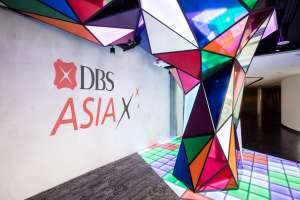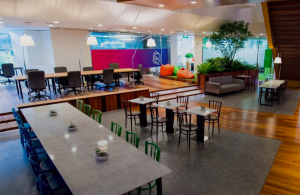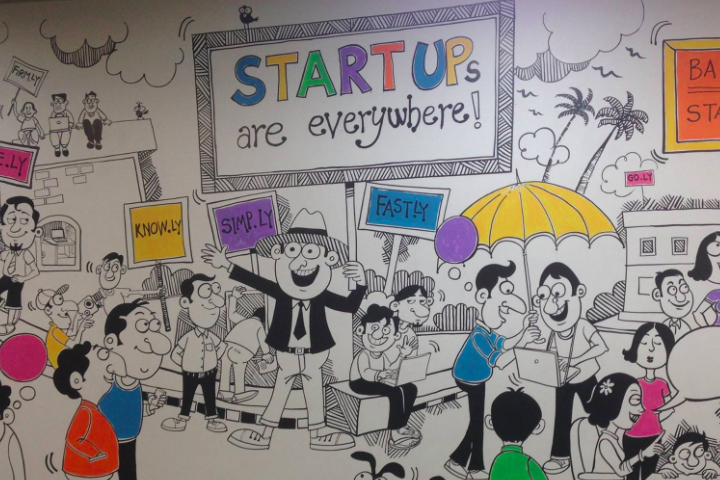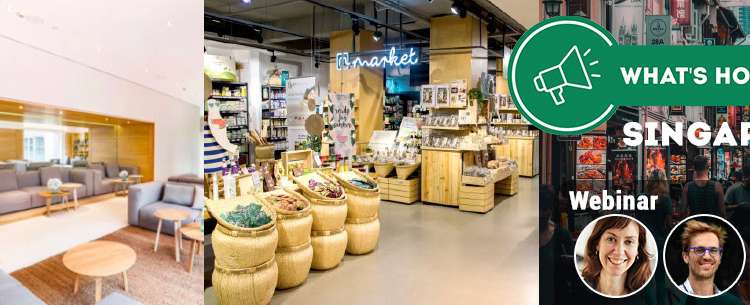Startups are here to stay. With access to endless data and more funding, start-ups will survive and therefore disrupt. Hence, the emergence of an innovation race amongst corporates. Everyone – from banks, industrials and even consumer goods companies – are obsessed with innovating. Innovation Labs, accelerators, transformation teams are mushrooming, but are often disconnected with the real business.
– How to engage the whole company in the transformation effort?
– How to create a digital culture and vision among your top managers?
– How can your teams identify new opportunities, new business models?
Changing a company’s culture can turn to be extremely challenging. But relax, we’re here to help! Here are 5 ways to foster a culture of innovation and identify opportunities in your company:
#1 Encourage an active learning culture by opening mindsets to new realities

For the Singaporean bank DBS, this space is where innovation will happen
Some companies do so by bringing inspiration to their offices and creating an ecosystem around them. For example, the Development Bank of Singapore (DBS) has created a special place for innovation: DBS Asia X (DAX). The building is entirely dedicated to innovation, hosting staff, startups, students and strategists together for better synergy. The facility is hosting the bank’s latest workshops and hackathons in collaboration with startups. Since 2015, DBS has involved more 2,000 staff into human-centred experimentations. Unilever also launched its own coworking, called LEVEL3, in under 5 months. For a simple reason, as shared by Derrick Chiang, CEO of the consultancy Padang & Co based in LEVEL3 “Rather than trying to constantly think of ways to ferry our staff to a tech conference, we can try to have a constant stream of content they can plug into, throughout the year”.

The working space at Level 3
While these initiatives may have a great impact on fostering innovation, not every company has the means to jump in these large-scale, high-cost projects. Another way to bring your team in is Lunch & Learn sessions. This is usually a 30 to 45 minutes sharing session, during lunchtime. The company brings in an expert to talk about a topic of innovation along with food, often provided by the company.
However, the office may not be the ideal place to innovate. Clients recognize that taking a step back from their core business and daily work is necessary to enable out-of-the-box thinking. So why not step outside the office! For example, through Learning Expeditions (LEX) or Inspiration Days; companies can meet experts, startups or innovative MNCs while keeping the costs low. Depending on your industry, you would be able to deep dive into the most advanced and relevant technologies for your business. You could explore the most cutting-edge Smart City solutions in Singapore, the fast-changing Internet of Things’ ecosystem in Shenzhen or the new retail revolution in Shanghai. Learning Expeditions are great ways to mingle technology and innovation scouting with cross-industry sharing and networking.

French MNC discovering Singapore’s innovation ecosystem
Learning Expeditions often go hand in hand with tech conferences. While some are very general and famous like CES Las Vegas or the Mobile World Congress in Barcelona, other conferences allow you to dive deeper into a topic of relevance for your business. Interested in FinTech? Be sure to attend the FinTech Festival in Singapore, and if you’re into IoT, don’t miss out on the China International Internet of Things Exhibition in Shenzhen. However, keep in mind that you can only unleash the full potential of these conferences (in terms of learnings and network) if it has been prepared properly beforehand. Those summits can be gigantic and turn unproductive if you don’t have a clear strategy.
#2 Offer free time for creative solutions
“I command you to create now!” is certainly not something you want to say to your staff, but you know that already. Yet, stressing that point is important. Quality takes time and we’re talking about free time. Employees must feel they are given the time and space to be creative, otherwise, they will think it is just an extra burden for them.
You might have heard of the famous 20% rule Google implemented in 2004, allowing Googlers to spend 20% of their time on projects of their choice, which has brought services like Gmail or Google News to life.
Singapore-based DBS Bank, the winner of the World’s Best Digital Bank, demonstrated this by establishing their “Massive Transformational Purpose” – Making Banking Joyful – which positioned consumer-focused experiments at the centre of their change process. As shared by Piyush Gupta, CEO of DBS: “When you give people the freedom to go and try a few things with a rubric that says, ‘As long as it helps the customer, it is worth doing,’ it opens people’s minds and it opens up a lot of possibilities”.

DBS launched “digibank” for its users to manage a various range of operations
You can also narrow the scope to suit your needs, by doing transformation workshops or Digital Advisory Boards. These two solutions focus on bringing the expertise of relevant individuals in your field back to you and your team. They help make new thinking possible by bringing in outside-in expertise, challenging existing views.
#3 Demystify failure and learn to reward risk-taking
Making mistakes is at the very essence of innovation. Coming up with new technologies or new ways of working implies taking a risk and moving fast (or at least faster than the competition). These parameters set the stage for making mistakes. But how can traditionally risk-averse corporations deal with them?
Mistakes should be made, analyzed and shared as opportunities to learn. People should be responsible for taking corrective actions immediately, based on these learnings. Take “Fuck Up Nights” for example. The concept, born in Mexico gives a space for people to share business failures and learn from it with the crowd. It has helped “destigmatize and explore the tough moments, to create a more solid foundation for innovation”.

Fuck Up Nights are ways to both destigmatize and build on past failures
Within organizations, some have found creative ways to make failure candid. A Singapore company has implemented an “immunity card” concept that employees can use in case of mistakes. While the concept sounds more like a gimmick, it formalizes the intent of the company to demystify failure and helps reassure risk takers within the company.
If demystifying failure is a must-have driver for innovation, the next step is to reward those who dare to fail. Many big players have already adopted such mindset. The Tata Group, for example, has created its “Dare to Fail Award”, while the software firm Intuit holds “failure parties”. The latter’s co-founder and CEO, Scott Cook stresses that “every failure teaches something important that can be the seed for the next great idea.” Companies like Mazars include these practices in long-term innovation-centric strategies to mould the corporate culture.
#4 Create a customer-centric culture: Get constant feedback from clients
Mark Zuckerberg declared to Harvard’s Class of 2017 Harvard that “the idea of a single eureka moment is a dangerous lie”, and he’s most certainly right. Innovation is powered by the customers and constantly listening to them is more important than racing for technology advancements. Customer-centric and design thinking approaches are, for example, at the core of companies such as Amazon or SAP.
Jeff Bezos, Amazon’s founder and CEO, constantly reminds decision teams of the place of the consumer by leaving an empty chair in the meeting room, where the customer, “the most important person in the room” seats.
To give a few examples of best practices by large traditional companies, SAP has put design thinking at the center of its culture with customer empathetic cognitive techniques, enabling collaborators to never lose sight of who and why they’re doing what they do for ; Adobe has embraced customer centricity with Customer Immersion Programmes (CIP), one of which is an experience-a-thon, organized for customers to test the company’s products for employees to take note and implement ; and a co-creation effort with millennial consumers has enabled legacy hospitality players like AccorHotels to disrupt their own model by focusing on the emerging needs of millennials.

The “Happy House” in the Jo&Joe, the millennial-targeting range of AccorHotels, in Hossegor, France.
#5 Celebrate successes in innovation
Celebrating innovation gives a very powerful message to the entire organization that innovation is an important component of the company.
Decathlon, for example, started its own annual Innovation Awards in 2005 which rewards the most innovative products launched by the company each year. It grew outside the company with more than 60 000 public web viewers in 2014.
Another example is Unilever’s Young Entrepreneurs Awards. By supporting young entrepreneurs around the world tackling some of the planet’s biggest sustainability challenges, the company spreads the message that it values entrepreneurship and sustainability.

The Decathlon Innovation Awards in 2016





